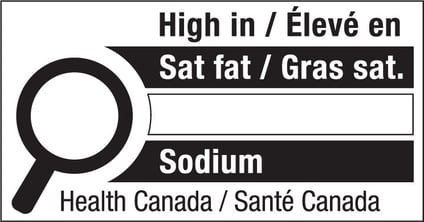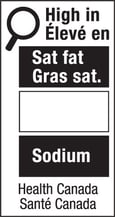In June 2022, Health Canada published amendments to the Food and Drug Regulations (FDR), creating a new requirement for packaged foods. The new regulation, Front-of-Package (FOP) nutrition labelling, requires that foods high in saturated fat, sugars, and/or sodium must include a symbol on the front of the package. Consumers will be able to use the symbol, which will include a magnifying glass, as a quick reference to better inform their dietary choices.
In our blog, we’ll go over the updated regulations, and include a list of the impacted foods and associated label requirements.
What is the new FOP regulation?
For foods sold in Canada, a front-of-package (FOP) symbol of a black and white magnifying glass is required for most prepackaged foods that meet or exceed set levels in one or more of these nutrients: sodium, sugars, and/or saturated fat. The FOP symbol will complement the Nutrition Facts table on the back of the package but will be easier for consumers to identify on the shelf. There are some exceptions to this regulation for prepackaged food (more on this below).
The regulation standardizes the size, location, and language of the symbol. Health Canada has provided two figures of the symbol as examples: a larger symbol for easy visibility and a smaller symbol for smaller packages.


Note that the symbol is in both English and French for Canadian consumers, and the governing body of “Health Canada / Santé Canada” is listed on the bottom. The English and French languages can be split into either two symbols (one for each language) or combined on the same symbol, as shown above, but both languages are required.
The symbol must be included on packages of any size and located in the upper half of the front label for most shapes. If the label is wider than it is tall, then the label should be included on the right half of the package.
September 2023 Update: Health Canada has released a proposed update regarding buffer space for supplemental foods and prepackaged foods that requires multiple FOP symbols on packaging. The change would allow for a buffer as small as 0 mm between FOP nutrition symbols and supplemented food caution identifier (FSCI) symbols. You can read a summary of this guidance on Health Canada's website.
Why are these changes happening?
Similar to health policy changes in the U.S., Health Canada is considering how to best inform consumers of their diet choices. FOP symbols have worked well in other countries, like Chile, and Canada is hoping to see success with their regulation as well. Diets that are high in sodium, sugars, or saturated fats can often lead to health complications, like a stroke, heart disease, certain cancers, or type 2 diabetes.
While the symbol will highlight nutrients that should be consumed in moderation, Health Canada is hoping it will serve a dual purpose of acting as a quick reference for consumers and supporting health professionals in educating people about dietary choices. Health Canada chose the magnifying glass symbol based on consumer research and feedback from people living in Canada.
When does the regulation go into effect?
While the rule went into effect in July 2022, the food industry has until January 1, 2026, to fully comply. However, food manufacturers are encouraged to adopt this new regulation as soon as possible.
What foods will be impacted by Canada's FOP update?
The new FOP symbol is required for most prepackaged foods that meet or exceed thresholds set for saturated fats, sugars, or sodium. The thresholds Health Canada created correspond to a percentage of daily value (% DV) per reference amount or serving size (whichever is greater) for those nutrients. Foods that fit these thresholds are broken into three categories:
- General prepackaged foods that meet or exceed 15% DV of saturated fat, sugars, or sodium. Examples include deli meats, soups, puddings, or frozen desserts.
- Prepackaged foods with a small reference amount (≤ 30 g or mL) that meet or exceed 10% DV of saturated fat, sugars, or sodium. Examples include pickles, salad dressing, breakfast cereals, and cookies.
- These foods have lower thresholds, as they often are consumed in smaller amounts and can be a concentrated source of the nutrients listed.
- Prepackaged main dishes with a reference amount of ≥ 200 g* that meet or exceed 30% DV of saturated fat, sugars, or sodium. Examples include frozen pasta dishes, meat pies, or pizzas.
- The thresholds are higher for these foods, as they are often consumed as a “main dish” and make up a larger portion of a person’s daily intake of nutrients.
- * This value changes to 170 g for main dishes intended solely for children 1-4 years old.
What foods are exempted from the FOP update?
Some prepackaged foods are exempted from displaying the new FOP symbol. These foods are exempt for three different reasons: health-related exemptions, technical exemptions, and practical exemptions. Health Canada explains each exemption in detail:
- Health-related exemptions include foods that have some recognized health benefit for the population or vulnerable sub-populations, foods that are formulated to meet the specific needs of specific populations (like military personnel meals), and foods that provide an important source of “shortfall nutrients” or nutrients that are often lacking in the average person’s diet (such as dairy products that provide added calcium). Some examples include:
- Dried, canned, fresh, or frozen whole or cut vegetables and fruits
- 2% and whole cow’s milk
- Cheese* and yogurt that contain naturally occurring (not added) saturated fat and sugars
- Eggs
- Vegetable oils, nuts, and fatty fishes that contain a “healthy fat profile”
- Any combination of these foods, with the exception of foods that have added ingredients that are high in saturated fats, sugars, and/or sodium.
- Technical exemptions include foods that do not require a Nutrition Facts table, foods that are not sold directly to consumers or with very small packaging (like coffee creamer cups), and foods that contain raw or single ingredient ground meat or poultry (if salt, saturated fat, or spices are added, then they may require a label). Some examples of these foods include:
- Raw, single-ingredient whole or ground meats, poultry, or fish
- Foods sold at a farmers’ market
- Mini chocolate bars, single-serving cups, coffee creamers, and other items in very small packaging
- Practical exemptions include foods on which the nutrition symbol would be redundant. Some examples include:
- Packages of table and flavored salt, sugar, honey, and maple syrup
- Butter and other fats and oils
*Health Canada notes: “many cheeses are exempt from requiring a nutrition symbol for sodium since sodium is required in the cheese-making process. For these products to benefit from an exemption they must contain a specific percentage of the DV for calcium. The ongoing need for this exemption will be reassessed after ten years.”
Where can I find more information?
Hungry for more knowledge? Lucky for you, Health Canada has provided the entire FOP regulation online, which includes other labelling provisions, definitions, and essential nutrients to declare.
How Trustwell can help
Genesis R&D Foods helps users comply with Health Canada FOP regulations by evaluating each nutrient of concern and calculating whether or not each nutrient meets or exceeds the threshold. A Front-of-Package symbol will appear next to the Nutrition Facts table on the View Label screen for each nutrient that meets or exceeds the threshold.
And last but not least, our team of compliance gurus are always available for a chat and regulatory review. To find out more about our services and their cost, fill out our contact form and a consulting representative will reach out to you.
Tag(s):
Food Labeling
Other posts you might be interested in
View All Posts
Product Formulation
28 min read
| October 9, 2025
Creating Compliant Canada Nutrition Facts Tables with Genesis Foods
Read More
Food Labeling
21 min read
| April 27, 2023
The Benefits of Front of Package Labeling for Consumers and Manufacturers
Read More
Trustwell News
6 min read
| March 18, 2025

